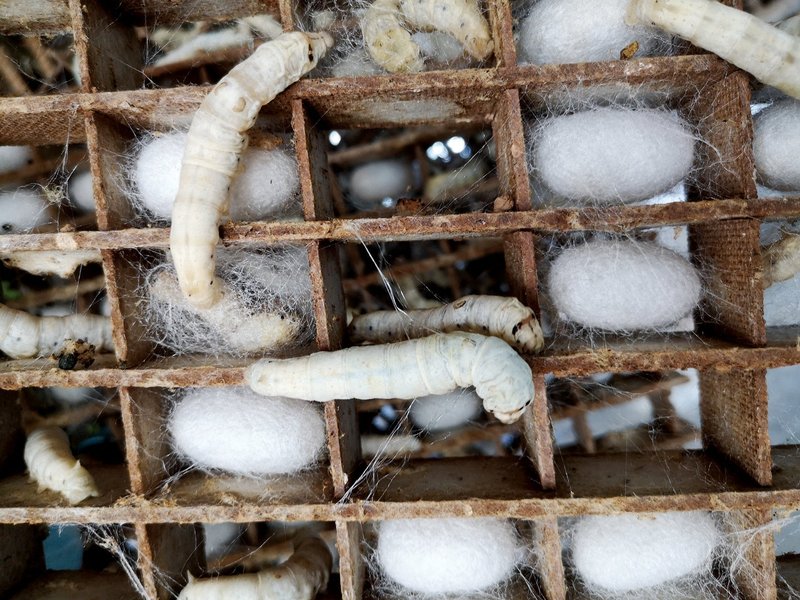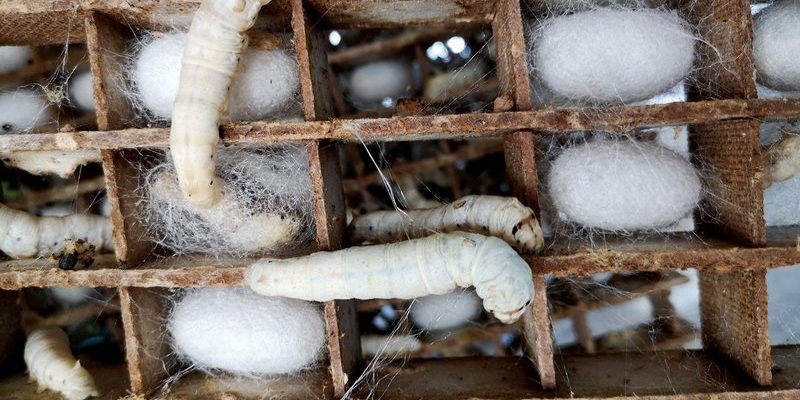
So, what exactly do these little critters do to produce silk? Well, let me break it down for you. Silkworms, specifically the larvae of the Bombyx mori moth, create silk through a process that’s as intricate as the fabric it produces. This isn’t just a simple task; it’s a fascinating dance of biology and craftsmanship in nature.
The Life Cycle of a Silkworm
To understand how silkworms produce silk threads, it’s essential to look at their life cycle. Silkworms go through several stages, starting as eggs, which eventually hatch into caterpillars. These caterpillars are the real silk-makers. They spend their days munching on mulberry leaves, growing rapidly until they’re ready for the next step.
After a few weeks of feasting, they enter the **pupal stage**. Here’s where the magic happens. The silkworms begin to spin a protective cocoon around themselves using silk threads. This cocoon isn’t just for show; it’s actually a kind of home that protects them while they transform into moths. The spinning process can take anywhere from a few hours to a couple of days, depending on the species and conditions.
During this time, the silkworm’s body produces silk from special glands. The liquid silk comes out in a fine thread, which they carefully wrap around themselves. It’s like they’re knitting their own little blanket that will later become the silk we wear!
The Silk Spinning Process
Now that we’ve covered the life cycle, let’s dive into the **silk-spinning process**. When a silkworm is ready to spin its cocoon, it uses two silk glands located in its head. These glands produce a protein called fibroin. When the fibroin comes into contact with air, it solidifies, forming a continuous thread.
You might be wondering how this works. Picture a tiny factory inside the silkworm, working non-stop to create these threads. The silkworm takes the fibroin and secretes it out in a figure-eight motion around its body. This back-and-forth spinning is what creates the smooth, long strands of silk. In just a few days, a single silkworm can produce a cocoon made up of thousands of feet of silk thread!
During this phase, the silk has a sticky quality, helping it stick to itself and form a strong structure. Once the cocoon is complete, it serves a crucial purpose: protecting the silkworm as it undergoes metamorphosis into a moth. Think of it like a cozy sleeping bag, providing a safe haven while it undergoes some serious changes.
Silk isn’t just one type of fabric; there are various kinds of silk threads produced by different species of silkworms. Each type has unique qualities and uses. The most well-known is **Mulberry silk**, produced by the Bombyx mori silkworm, which is commonly farmed for commercial silk production.
Another interesting variety is **Tussah silk**, made from wild silkworms that feed on oak and other leaves. Compared to mulberry silk, tussah has a coarser texture and a more rustic appearance. It’s perfect for those looking for something a little different in their silk garments.
Then there’s **Muga silk**, exclusive to India, known for its rich golden color and durability. It’s a prized possession in traditional garments and has a beautiful sheen that many people adore. Each type of silk has its own unique charm, showcasing the diversity of this incredible natural material.
You might wonder how silkworms manage to produce silk. The answer lies in their diet. **Mulberry trees** are the primary food source for silkworms, specifically their leaves. These leaves are rich in nutrients, which support the silkworm as it grows and produces silk.
The relationship between silkworms and mulberry trees is like a classic teamwork scenario. Without these trees, silkworms wouldn’t thrive, and silk production would grind to a halt. Mulberry trees are planted in large quantities in areas known for silk farming, providing a steady supply of food for the silkworms.
This synergy highlights how nature occasionally creates beautiful partnerships. The trees offer sustenance, and in return, silkworms produce silk, which has been cherished by humans for thousands of years. It’s a win-win situation—nature at its finest!
Once the silkworm has spun its cocoon, the next step is harvesting the silk. This process is crucial and involves carefully collecting the cocoons. To obtain the silk threads, farmers typically use hot water or steam to kill the pupa inside. This process must be handled with care, as the goal is to keep the long silk threads intact.
After boiling, the silk can be unwound from the cocoon. You can think of it like unrolling a very delicate piece of string. Skilled hands are needed to make sure the silk doesn’t break. The result is long, shiny threads that can be dyed and woven into beautiful fabrics.
It’s important to note that silk harvesting must be done ethically. Luckily, there are some farms now that focus on **peace silk**, which allows the silkworm to emerge before the silk is harvested. This option provides a more humane way to enjoy the benefits of silk without harming the little creators.
Silk isn’t just a fancy fabric; it holds a significant place in culture and history. For centuries, silk has been associated with wealth and luxury. Countries like China and India have deep-rooted traditions in silk production, which also contribute significantly to their economies.
In many Asian cultures, silk fabrics are used for clothing, home decor, and even ceremonial occasions. Silk production supports local farmers and artisans, creating jobs and income for communities. The intricate designs and patterns often tell stories, representing cultural heritage and craftsmanship passed down through generations.
You might be surprised to learn that the demand for silk remains high even today. With more people appreciating handmade and unique fabrics, silk continues to captivate fashion lovers worldwide. It’s more than just a piece of fabric; it’s a connection to nature and a rich history.
Before we wrap things up, let’s share a few fun facts about silkworms that might surprise you!
- Silkworms can spin over 1,000 meters of silk in a day! That’s longer than ten football fields!
- They only eat mulberry leaves. A strict diet is key to their silk-producing abilities.
- Silkworms can produce about 300,000 silk threads per cocoon. That’s a lot of silk from one tiny worm!
- Silk production dates back to ancient China. The oldest evidence of silk use is over 5,000 years old.
Silkworms are truly amazing creatures that play an essential role in one of the world’s most beloved fabrics.
As you can see, the journey of silk from a silkworm to fabric is a fascinating blend of nature, craftsmanship, and history. From their spinning process to the cultural significance of silk, there’s so much to appreciate about these tiny creatures and the beautiful threads they produce. So next time you wear silk, take a moment to think about the incredible journey it took to get to you!

